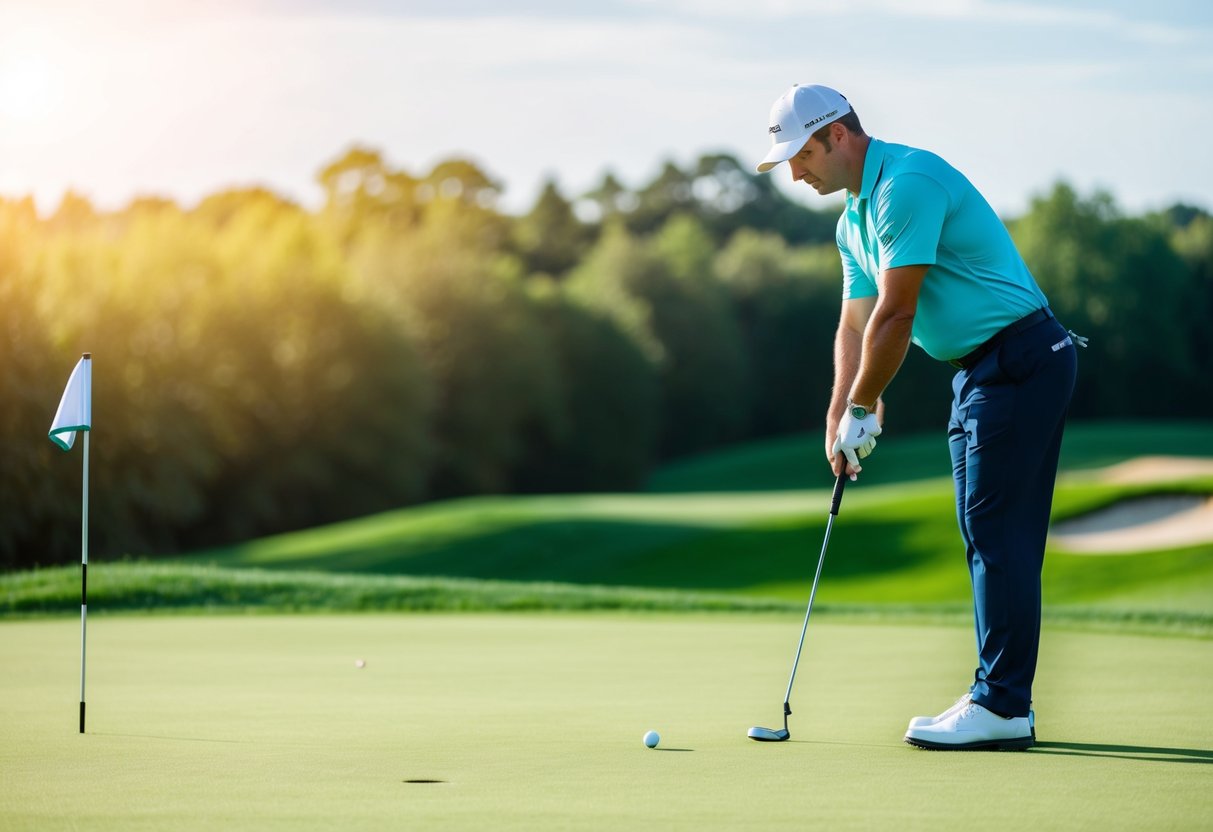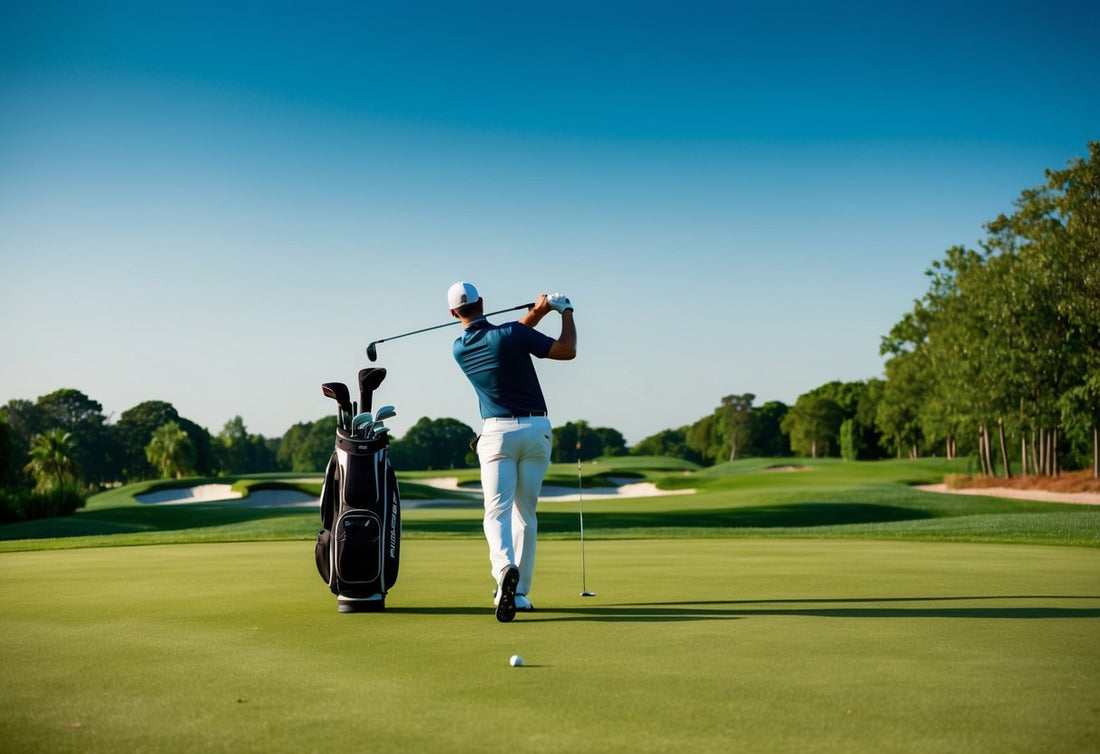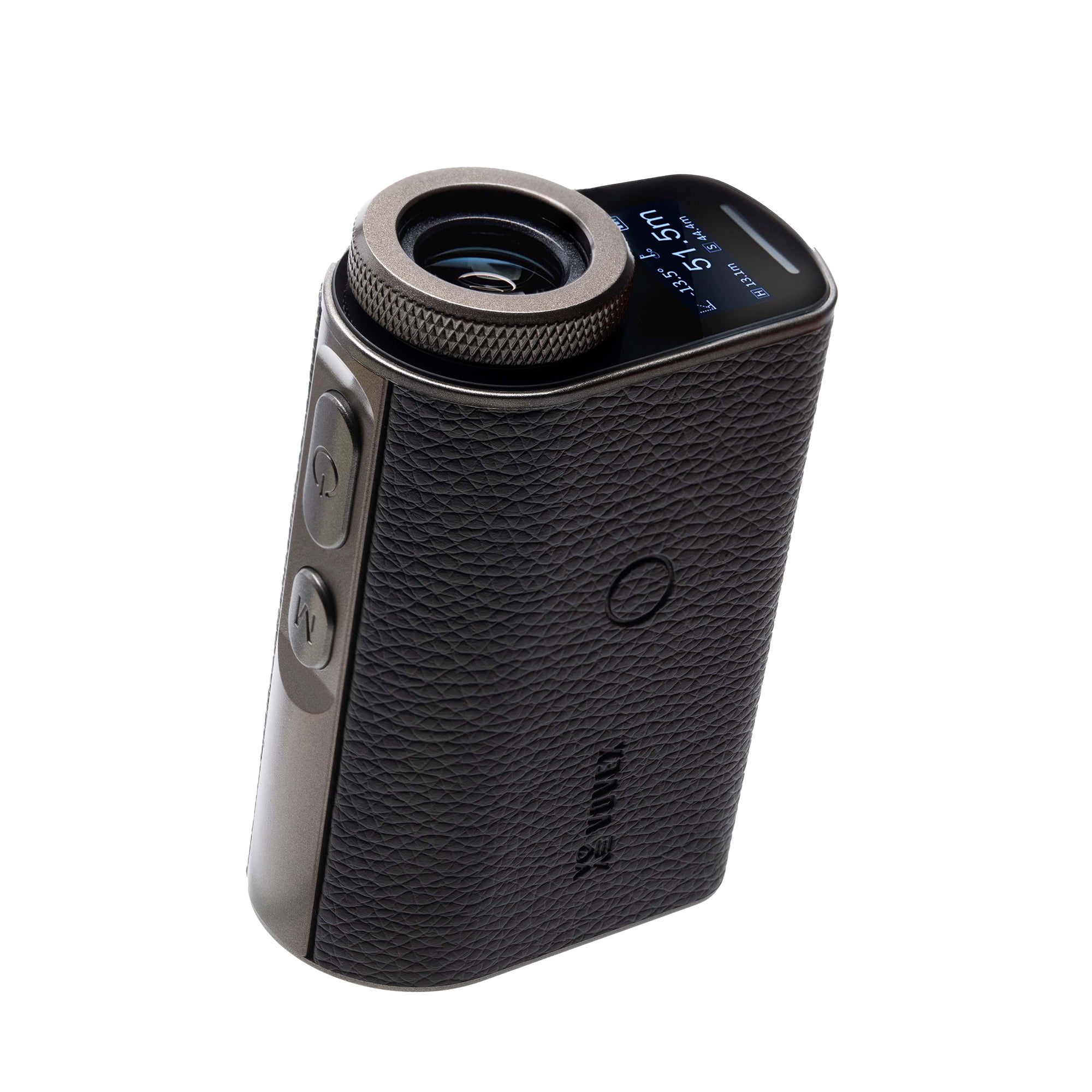Check out our golf rangefinders by Vovex to elevate your game!
Standing on the tee box, every golfer faces a crucial decision: which club will deliver the perfect shot? This choice can make or break your round, yet many players rely on guesswork rather than precision. A golf rangefinder eliminates this uncertainty by providing exact yardages to targets, allowing you to select the optimal club based on your personal distance capabilities rather than estimation.
We've all experienced those frustrating moments when a seemingly perfect swing ends up short of the green or sails over into trouble. The science behind club selection involves understanding not just distances, but how factors like elevation changes and weather conditions affect ball flight. Rangefinders give you this critical data instantly, transforming club selection from an art of approximation into a science of precision.
Key Takeaways
- Rangefinders provide exact distance measurements that eliminate guesswork and improve confidence in club selection decisions.
- Understanding how environmental factors affect your shots becomes easier with accurate distance data from a reliable rangefinder.
- Regular practice with a rangefinder creates a personalized distance profile for each club in your bag, leading to more consistent results on the course.
Unveiling the Golf Rangefinder
Golf rangefinders have revolutionized the way golfers approach their shots on the course. These compact devices use laser technology to measure the exact distance to flags, hazards, and other points of interest. We've seen tremendous advancements in this technology over the past decade.
Most modern rangefinders provide measurements accurate within one yard. They work by emitting a laser beam that bounces off your target and returns to the device, calculating distance based on how long the beam takes to return.
There are three main types of golf rangefinders available today:
- Laser Rangefinders: Direct measurements to visible targets
- GPS Rangefinders: Pre-loaded course maps with fixed point distances
- Hybrid Models: Combining both laser and GPS technologies
The size and weight of these devices have decreased significantly. Many now fit comfortably in your pocket or attach easily to your golf bag. Battery life has also improved, with most models lasting multiple rounds on a single charge.
Advanced features in premium models include slope calculation, which factors in elevation changes. Some even offer "playing distance" recommendations that account for wind and temperature effects on ball flight.
We've found that waterproof models are worth the investment, especially for golfers who play in varied weather conditions. The durability of these devices has improved dramatically, with many able to withstand the occasional drop or bump.
Deciphering Distances: The Foundation of Club Selection
Knowing the precise distance to your target is the cornerstone of effective club selection. Without accurate distance information, even the most skilled golfers are essentially guessing which club to use.
Traditional methods of estimating distances—like eyeballing or using course markers—leave too much room for error. We've all experienced the frustration of watching a seemingly perfect shot fall short or sail over the green.
Distance factors that affect club selection:
- Actual yardage to the target
- Elevation changes
- Wind conditions
- Temperature
- Humidity
A rangefinder eliminates the guesswork by providing exact measurements to the flag, hazards, or landing areas. This precision allows us to confidently select the appropriate club based on our personal distance capabilities.
Most golfers develop a distance chart for each club in their bag. For example, a typical amateur might hit their 7-iron 150 yards, while their 8-iron travels 140 yards. With exact yardage information from a rangefinder, matching these distances becomes straightforward.
Modern rangefinders offer additional features that enhance club selection even further. Slope-measuring capabilities account for elevation changes, adjusting the displayed distance to reflect the true playing distance uphill or downhill.
Weather conditions still require judgment, as wind and temperature affect ball flight significantly. However, starting with an accurate base measurement removes the largest variable from the equation.
Professional golfers rely on precise yardages for every shot. With a quality rangefinder, we can bring that same level of precision to our game.
The Role of Course Topography in Club Choice
When playing golf, the lay of the land significantly impacts how far our ball travels. Uphill shots require more power, as gravity works against the ball's trajectory. Downhill shots, conversely, need less power since gravity adds distance to our shots.
A quality rangefinder helps us account for these elevation changes. Many modern models include slope-adjusted distances, showing both the actual yardage and the "plays like" distance that factors in elevation.
Uphill Shots:
- Typically require 1-2 clubs more than the measured distance
- 10 feet of elevation gain ≈ 1-2 yards of additional distance needed
- Ball flight will be higher with less roll
Downhill Shots:
- Usually require 1-2 clubs less than measured distance
- 10 feet of elevation drop ≈ 2-3 yards of reduced distance needed
- Ball tends to roll further upon landing
Side slopes also affect our club selection. When the ball sits above our feet, we might choose a club with less loft as the ball tends to draw. When below our feet, the ball often fades, so adjusting our aim or club choice becomes necessary.
Wind patterns vary with elevation changes too. Higher spots on the course may experience stronger winds than sheltered valleys. Our rangefinder provides accurate distances, but we must factor in these topographical elements when making our final club selection.
Weather Conditions and Their Effect on Club Range
Weather plays a crucial role in how far your golf ball travels. Understanding these effects helps golfers make better club selections when using their rangefinders.
Wind is perhaps the most significant weather factor affecting club distance. A headwind can reduce your shot distance by 10-15 yards, requiring you to select a stronger club. Conversely, a tailwind might add 10-20 yards, suggesting you should club down.
Temperature also matters significantly. Warmer air is less dense, allowing the ball to travel farther. For every 10-degree increase in temperature, you might gain 1-2 yards of distance.
Humidity affects ball flight in a surprising way. Higher humidity actually helps your ball travel farther because moist air is less dense than dry air. This effect is subtle—typically only 1-3 yards—but worth considering in extremely humid conditions.
Altitude changes dramatically impact club selection. At higher elevations, the air is thinner, causing the ball to travel farther.
| Altitude Increase | Approximate Distance Gain |
|---|---|
| 1,000 feet | 2-3% (4-6 yards on a 200-yard shot) |
| 5,000 feet | 10-12% (20-24 yards on a 200-yard shot) |
Rain and wet conditions reduce roll after landing. We recommend adding one club for shots where you typically count on roll, as the ball will stop more quickly on wet surfaces.
Mastering the Art of Club Selection with Rangefinder Insights
Accurate club selection separates average golfers from exceptional ones. A rangefinder provides critical distance information, but translating that data into the perfect club choice requires both science and experience.
Reading the Rangefinder: Basics for Beginners
Getting started with a rangefinder is straightforward once you understand the fundamentals. We recommend holding the device with both hands for stability, then aiming at your target by looking through the viewfinder.
Most models feature a simple button press to activate measurement. The distance will display in yards or meters, depending on your settings.
Key measurements to take:
- Distance to the pin
- Distance to hazards (bunkers, water)
- Distance to the front/back of the green
Remember that slope-enabled rangefinders provide adjusted distances that account for elevation changes. This feature can be toggled off for tournament play when required by rules.
Practice using your rangefinder on the driving range first. Measure distances to various targets to build confidence before taking it to the course.
From Data to Decision: Translating Rangefinder Information
Converting precise distance readings into club selections requires understanding your personal distance ranges. We suggest creating a simple chart of your typical distances with each club.
Sample distance chart:
| Club | Average Distance | Range |
|---|---|---|
| 7-iron | 150 yards | 145-155 yards |
| 8-iron | 140 yards | 135-145 yards |
| 9-iron | 130 yards | 125-135 yards |
Don't just consider the raw distance. Factor in wind conditions, temperature, and lie quality. A shot playing into the wind might require one club stronger than normal.
Course conditions matter too. Firm fairways add roll, while soft conditions reduce it. Uphill shots play longer; downhill shots play shorter.
We've found the "80% rule" useful - choosing a club that requires about 80% effort often produces more consistent results than swinging at 100% with a weaker club.
Rangefinders and Handicap Improvement
Using accurate distance measurements consistently leads to better club selection and lower scores over time. Rangefinders provide the reliable data needed to make meaningful improvements to your handicap through both technical and psychological advantages.
Tracking Progress Over Time with Technology
Modern rangefinders offer more than just yardage readings - they're powerful tools for tracking performance trends. Many models now sync with smartphone apps to record club distances and dispersions across multiple rounds.
This data collection reveals patterns that might otherwise go unnoticed. For example, we've found that golfers often discover their 7-iron actually travels 10-15 yards less than they believed, leading to consistent short approaches.
With accurate measurements from your rangefinder, you can build a personalized distance chart for each club in your bag. This eliminates guesswork and helps you select the optimal club for every situation.
Example of Distance Tracking Progress:
- Week 1: 7-iron average = 145 yards (10 shots measured)
- Week 6: 7-iron average = 152 yards (improved technique)
- Week 12: 7-iron average = 155 yards (consistent performance)
Strengthening Mental Game Through Informed Choices
Confidence comes from certainty. When we know exactly how far we need to hit the ball, decision-making becomes decisive rather than doubtful.
Rangefinders eliminate the anxiety of uncertain distances. This mental clarity allows golfers to focus on execution rather than second-guessing club selection.
The psychological benefit extends beyond individual shots. Knowing we've chosen the right club based on precise measurements creates a positive feedback loop of confidence.
We've observed that golfers who use rangefinders consistently report feeling more in control of their game. This control translates to fewer "blow-up holes" where multiple mistakes compound into high scores.
The reduced stress and improved focus directly impact handicap reduction. Many golfers report dropping 2-4 strokes simply from eliminating distance-related errors.
Choosing the Right Rangefinder for Your Golf Bag
When selecting a golf rangefinder, we believe accuracy should be your primary consideration. Most quality rangefinders offer accuracy within ±1 yard, which is sufficient for most golfers' needs.
Size and weight matter significantly since you'll be carrying this device throughout your round. Modern rangefinders have become increasingly compact, with many weighing less than 8 ounces and easily fitting into pocket-sized compartments in your golf bag.
Budget is naturally a key factor in your decision. Rangefinders typically range from $150 to $500, with more expensive models offering advanced features like slope calculation and superior optics.
Key Features to Consider:
- Slope Technology: Accounts for elevation changes
- Pin-seeking Technology: Helps lock onto flags rather than background objects
- Magnification: Typically 5x-7x for golf rangefinders
- Battery Life: Look for devices lasting 10+ rounds
Water resistance is essential for those unexpected rain showers. Many premium rangefinders offer IPX4 or better water resistance ratings.
Tournament legality should be considered if you play competitive golf. Models with slope features often include a tournament mode that disables this function to comply with USGA rules.
We've found that brands like Bushnell, Nikon, and Garmin consistently produce reliable golf rangefinders with excellent customer support and warranty options.
Try before you buy whenever possible. The feel of the device in your hand and clarity of the display can significantly impact your user experience on the course.
Integrating Rangefinders into Practice Sessions
Effective practice with a rangefinder transforms your distance control and club selection accuracy. The device becomes most valuable when incorporated systematically into your training routine rather than saved exclusively for tournament play.
Developing Consistent Pre-Shot Routines
Rangefinders should become a natural extension of your pre-shot process. Begin by measuring the distance to your target before selecting a club. This creates muscle memory for proper distance assessment.
We recommend practicing a simple three-step routine: measure, visualize, then execute. Take your rangefinder reading, mentally picture the shot trajectory, then make your swing.
Be disciplined about using your rangefinder for every shot during practice, not just the uncertain ones. This builds confidence in your distance judgments over time.
Track your actual results against the rangefinder readings in a small notebook. Note any patterns where you consistently over or underestimate distances with certain clubs.
Precision Practice: Targeting Specific Skills
Rangefinders enable highly focused practice sessions targeting specific distance gaps in your game. Set up stations at precise yardages - perhaps at 10-yard increments throughout your iron range.
Try this drill: Place markers at exact distances (verified by rangefinder) and hit 5 balls to each target, recording how many land within 15 feet. This reveals your actual distance control capabilities.
Use your rangefinder to practice uncomfortable distances. Many golfers have "in-between" yardages where they struggle to commit to a club choice.
When practicing bunker shots or approaches, measure multiple points: to the hazard, to the pin, and to the back edge. This builds a comprehensive spatial awareness that translates directly to the course.
Ethics of Rangefinder Usage in Competitive Play
Rangefinders have sparked significant debate in competitive golf circles. The USGA and R&A modified Rule 4.3a in 2019, allowing rangefinder use in standard play but giving tournament committees the option to prohibit them through Local Rules.
Professional tours have varied approaches to this technology. The PGA Tour prohibits rangefinders during regular tournament rounds, believing players should rely on traditional course management skills and caddie expertise.
However, the PGA of America has permitted rangefinders in its major championships since 2021. They argue that these devices can improve pace of play—a crucial consideration in today's golf landscape.
Key Considerations for Competitive Players:
- Check tournament rules before using a rangefinder
- Understand which features are permitted (slope functions are typically banned)
- Respect the spirit of competition regardless of available technology
We've noticed that amateur tournaments often follow professional guidelines. College and high school competitions typically allow basic distance-measuring devices while prohibiting slope-adjusted readings.
When we use rangefinders respectfully and within established rules, they enhance rather than diminish the game. The ethical player understands that technology should complement skill, not replace the fundamental challenges that make golf special.
Many golf purists believe that course management and distance estimation are essential skills that shouldn't be bypassed with technology. This perspective deserves consideration even as we embrace modern tools.
Evolving Golf: Rangefinders Shaping the Future of the Game
Golf rangefinders are revolutionizing how we approach the game. These devices have moved from luxury items to essential tools for players seeking precision and improvement in their performance.
The integration of rangefinders into professional tournaments marks a significant shift in competitive golf. While the PGA Tour now permits rangefinders in certain events, their influence extends beyond professional play to how amateur golfers develop their skills.
Modern rangefinders incorporate AI and machine learning to analyze more than just distance. New models can assess wind conditions, elevation changes, and even suggest club selection based on your personal swing data.
The connectivity between rangefinders and smartphones has created an ecosystem of golf improvement. Players can track their club distances over time, identify patterns, and make data-driven decisions about equipment and technique.
Key Rangefinder Innovations Shaping Golf's Future:
- Slope-adjusted measurements for more accurate uphill/downhill shots
- Shot tracking capabilities that build a performance database
- Voice command features for hands-free operation
- Augmented reality displays showing hazards and ideal landing zones
We're seeing rangefinders become smaller, more durable, and longer-lasting. The latest models offer full-day battery life and weatherproof designs that withstand the elements.
For teaching professionals, rangefinders have transformed coaching methods. They provide immediate, objective feedback that helps students understand concepts like distance control and club gapping more concretely.
The democratization of rangefinder technology means more golfers at all levels can access tools once reserved for the elite. This technology is making precision golf more accessible to everyone who loves the game.
Frequently Asked Questions
Golfers often have specific questions about rangefinders and their impact on club selection. These devices have revolutionized how players approach shots on the course, but understanding their full potential requires addressing common concerns.
How do rangefinders enhance decision-making on the golf course?
Rangefinders provide precise distance measurements that eliminate guesswork. When we know exactly how far we are from the pin or hazard, we can select the appropriate club with confidence rather than estimation.
This precision leads to better shot planning, especially on unfamiliar courses. Instead of relying on course markers that might only give general distances to the center of the green, we can target specific landing areas.
The data from rangefinders also helps us build a personal distance profile for each club in our bag. Over time, this information becomes invaluable for developing course management strategies and improving overall performance.
What features should I look for in a golf rangefinder to improve club selection?
Slope measurement capability is crucial as it accounts for elevation changes that affect shot distance. A rangefinder that calculates how much uphill or downhill shots will play can drastically improve club selection accuracy.
Look for models with pin-seeking technology that confirms when you've locked onto the flagstick. This feature prevents measuring to objects behind the green, which could lead to club selection errors.
Battery life and durability matter for consistent on-course use. Nothing is more frustrating than having your rangefinder die midway through a round when facing a critical club selection decision.
Can using a rangefinder lower my handicap by ensuring better club choices?
Yes, consistent use of a rangefinder typically leads to handicap improvement for most golfers. By selecting the right club more often, we reduce the number of shots lost to distance misjudgments.
Studies show amateur golfers often miss greens due to distance control rather than directional errors. A rangefinder directly addresses this weakness by providing accurate yardages for more informed club selections.
The improvement isn't instant but develops as we gather data on our actual club distances. Many golfers report dropping 2-4 strokes after incorporating rangefinder data into their game for several months.
What's the impact of rangefinder accuracy on choosing the correct club for a shot?
Even small variations in measured distance can lead to different club selections. A difference of 5-7 yards might mean choosing between a 7-iron and an 8-iron for many players.
Modern rangefinders typically offer accuracy within ±1 yard, which is sufficient for making confident club selections. This level of precision helps eliminate the "in-between clubs" dilemma that plagues many golfers.
Weather conditions can affect rangefinder accuracy, particularly in fog or heavy rain. We should be aware of these limitations and factor them into our decision-making process during adverse conditions.
How do professionals decide on a club when rangefinders are not permitted in tournaments?
Professional golfers rely heavily on yardage books and pre-tournament preparation. These detailed guides contain precise measurements to various points on each hole, created during practice rounds.
Caddies play a crucial role by stepping off distances from sprinkler heads and course markers. Their experience and knowledge of the player's tendencies inform club recommendations.
Pros also develop an exceptional feel for distance through years of practice. They've hit thousands of shots with each club and can often gauge distances remarkably well through visual assessment alone.
What are the limitations of rangefinders in gauging the ideal club to use?
Rangefinders can't account for wind conditions, which significantly impact ball flight and distance. We still need to assess wind direction and strength independently when making club selections.
They don't consider lie conditions that affect how cleanly we'll strike the ball. A poor lie might require clubbing up regardless of the measured distance.
Most basic rangefinders don't factor in temperature and humidity, which affect how far the ball travels. In very hot or cold conditions, we may need to adjust our club selection beyond what the rangefinder suggests.






